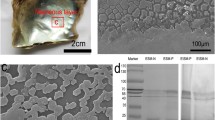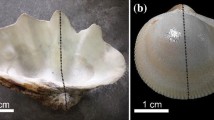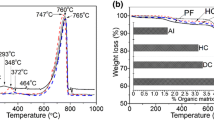Abstract
Mollusc shells are organic–inorganic biocomposites, arranged in a limited number of superimposed calcified layers that generally exhibit very different organization of their crystallites. Because of their attractive mechanical and crystallographic properties, these shell layers have been the focus of several physical and biochemical characterizations. In particular, recent proteomic data obtained from individual layers suggest that their protein contents are different. However, the direct visual evidence that some macromolecular components are layer-specific is rather tenuous. This paper is based on a non-conventional immunogold labelling approach to localize proteins in the shell of the edible oyster Crassostrea gigas. The shell microstructure of this model organism is predominantly composed of foliated calcite, interspersed by discontinuous pockets of ‘chalky layers’, a porous microstructure typical of bivalves of the ostreid family. By developing a polyclonal antibody (in two rats) elicited against a proteinaceous shell fraction, we obtained differential staining of the two microstructures. We assert that our labelling is microstructure discriminant. The difference in labelling of the two shell microstructures suggests either that they are formed by a variation of the secretory repertoire of the shell-forming cells of the calcifying mantle epithelium or that the chalky layer may be formed via a completely different mechanism. Our results allow a first glimpse on the subtle regulatory mechanisms that drive the process of chalky and foliated layers deposition.







Similar content being viewed by others
References
Addadi L, Joester D, Nudelman F, Weiner S (2006) Mollusk shell formation: a source of new concepts for understanding biomineralization processes. Chem-Eur J 12:980–987. doi:10.1002/chem.200500980
Ahr WM (2008) Geology of carbonate reservoirs. Wiley, Hoboken
Albeck S, Aizenberg J, Addadi L, Weiner S (1993) Interactions of various skeletal intracrystalline components with calcite crystals. J Am Chem Soc 115:11691–11697. doi:10.1021/ja00078a005
Bougeois L, de Rafélis M, Reichart G-J, de Nooijer LJ, Nicollin F, Dupond-Nivet G (2014) A high resolution study of trace elements and stable isotopes in oyster shells to estimate Central Asian Middle Eocene seasonality. Chem Geol 363:200–212. doi:10.1016/j.chemgeo.2013.10.037
Bougeois L, de Rafélis M, Reichart G-J, de Nooijer LJ, Dupond-Nivet G (2016) Mg/Ca in fossil oyster shells as palaeotemperature proxy, an example from the Palaeogene of Central Asia. Palaeogeogr Palaeoclim Palaeoecol 441:611–626. doi:10.1016/j.palaeo.2015.09.052
Bricteux-Grégoire S, Duchâteau-Bosson G, Jeuniaux C, Florkin M (1964) Constituants osmotiquement actifs des muscles adducteurs de Gryphaea angulata adaptée à l’eau de mer ou à l’eau saumâtre. Arch Int Phys Bioch 72:835–842
Carter JG (1990) Evolutionary significance of shell microstructure in the Palaeotaxodonta, Pteriomorphia and Isofilibranchia (Bivalvia: Mollusca). In: Carter JG (ed) Skeletal biomineralization: patterns, processes and evolutionary trends. Van Nostrand Reinhold, New York, Chapter 10, pp 135–296
Carter JG, Clark GR II (1985) Classification and phylogenetic significance of mollusk shell microstructures. In: Broadhead TW (ed) Mollusk, note for a short course, studies in geology 13, Dpt of geological sciences. University of Tennessee Press, Tennessee, pp 50–71
Chinzei K (2013) Adaptation of oysters to life on soft substrates. Hist Biol 25:223–231. doi:10.1080/08912963.2012.727412
Clark MF, Adams AN (1977) Characteristics of the microplate method of enzyme-linked immunosorbent assay for the detection of plant viruses. J Gen Virol 34:475–483. doi:10.1099/0022-1317-34-3-475
Cranford S, Buehler MJ (2010) Materiomics: biological protein materials, from nano to macro. Nanotechnol Sci Appl 3:127–148
Fleury C, Marin F, Marie B, Luquet G, Thomas J, Josse C, Serpentini A, Lebel JM (2008) Shell repair process in the green ormer Haliotis tuberculata: a histological and microstructural study. Tissue Cell 40:207–218
Gosling E (2003) Bivalve molluscs: biology, ecology and culture. Wiley-Blackwell, Oxford
Hanly WC, Artwohl JE, Bennett BT (1995) Review of polyclonal antibody production procedures in mammals and poultry. ILAR J 37:93–118. doi:10.1093/ilar.37.3.93
Jia L, Cai C, Yang H, Li H, Wang T, Zhang B, Jiang L, Tao X (2015) Thermochemical and bacterial sulfate reduction in the Cambrian and Lower Ordovician carbonates in the Tazhong Area, Tarim Basin, NW China: evidence from fluid inclusions, C, S, and Sr isotopic data. Geofluids 15:421–437. doi:10.1111/gfl.12105
Kanold JM, Immel F, Broussard C, Guichard N, Plasseraud L, Corneillat M, Alcaraz G, Brümmer F, Marin F (2015) The test skeletal matrix of the black sea urchin Arbacia lixula. Comp Biochem Physiol D 13:24–34. doi:10.1016/j.cbd.2014.12.002
Korringa P (1951) On the nature and function of “chalky” deposits in the shell of Ostrea edulis Linnaeus. Proc Calif Acad Sci 27: 133–158
Langlet D, Alunno-Bruscia M, de Rafélis M, Renard M, Roux M, Schein E, Buestel D (2006) Experimental and natural cathodoluminescence in the shell of Crassostrea gigas from Thau lagoon (France): ecological and environmental implications. Mar Ecol Prog Ser 317:143–156. doi:10.3354/meps317143
Lartaud F (2007) Les fluctuations haute fréquence de l’environnement au cours des temps géologiques. Mise au point d’un modèle de référence actuel sur l’enregistrement des contrastes saisonniers dans l’Atlantique nord. Ph.D. thesis, UPMC-Paris 06, Paris
Lartaud F, Emmanuel L, de Rafélis M, Ropert M, Labourdette N, Richardson CA, Renard M (2010a) A latitudinal gradient of seasonal temperature variation recorded in oyster shells from the coastal waters of France and The Netherlands. Facies 56:13–25. doi:10.1007/s10347-009-0196-2
Lartaud F, de Rafélis M, Ropert M, Emmanuel L, Geairon P, Renard M (2010b) Mn labelling of living oysters: artificial and natural cathodoluminescence analyses as a tool for age and growth rate determination of C. gigas (Thunberg, 1793) shells. Aquaculture 300:206–217. doi:10.1016/j.aquaculture.2009.12.018
Le Roy N, Jackson DJ, Marie B, Ramos-Sylva P, Marin F (2014) The evolution of metazoan α-carbonic anhydrases and their roles in calcium carbonate biomineralization. Front Zool 11:75. doi:10.1186/s12983-014-0075-8
Lowenstam HA, Weiner S (1989) On biomineralization. Oxford University Press, New-York
Margolis SV, Carver RE (1974) Microstructure of chalky deposits found in shells of the oyster Crassostrea virginica. Nautilus 88:62–65
Marie B, Luquet G, Pais De Barros J-P, Guichard N, Morel S, Alcaraz G, Bollache L, Marin F (2007) The shell matrix of the freshwater mussel Unio pictorum (Paleoheterodonta, Unionoida)—involvement of acidic polysaccharides from glycoproteins in nacre mineralization. FEBS J 274:2933–2945. doi:10.1111/j.1742-4658.2007.05825.x
Marie B, Marin F, Marie A, Bédouet L, Dubost L, Alcaraz G, Milet C, Luquet G (2009) Evolution of nacre: biochemistry and proteomics of the shell organic matrix of the cephalopod Nautilus macromphalus. ChemBioChem 10:1495–1506. doi:10.1002/cbic.200900009
Marie B, Le Roy N, Luquet G, Zanella-Cléon I, Becchi M, Marin F (2010) Proteomic analysis of the acid-soluble nacre matrix of the bivalve Unio pictorum: detection of novel carbonic anhydrase and putative protease inhibitor proteins. ChemBioChem 11:2138–2147. doi:10.1002/cbic.201000276
Marie B, Zanella-Cléon I, Guichard N, Becchi M, Marin F (2011) Novel proteins from the calcifying shell matrix of the Pacific oyster Crassostrea gigas. Mar Biotechnol 13:1159–1168. doi:10.1007/s10126-011-9379-2
Marie B, Joubert C, Tayalé A, Zanella-Cléon I, Belliard C, Piquemal D, Cochennec-Loreau N, Marin F, Gueguen Y, Montagnani C (2012) Different secretory repertoires control the biomineralization processes of prisms and nacre deposition of the pearl oyster shell. Proc Natl Acad Sci USA 109:20986–20991. doi:10.1073/pnas.1210552109
Marin F (2003) Molluscan shell matrix characterization by preparative SDS-PAGE. Sci World J 3:342–347. doi:10.1100/tsw.2003.30
Marin F, Gillibert M, Westbroek P, Muyzer G, Dauphin Y (1999) Evolution: disjunct degeneration of immunological determinants. Geol Mijnbouw 78:135–139. doi:10.1023/A:1003882928828
Marin F, Corstjens P, De Gaulejac B, De Vrind-De Jong E, Westbroek P (2000) Mucins and molluscan calcification: molecular characterization of mucoperlin, a novel acidic mucin-like protein of the nacreous shell-layer of the fan mussel Pinna nobilis (Bivalvia, Pteriomorphia). J Biol Chem 275:20667–20675. doi:10.1074/jbc.M003006200
Marin F, Pereira L, Westbroek P (2001) Large-scale fractionation of molluscan shell matrix. Protein Expres Purif 23:175–179. doi:10.1006/prep.2001.1487
Marin F, Amons R, Guichard N, Stigter M, Hecker A, Luquet G, Layrolle P, Alcaraz G, Riondet C, Westbroek P (2005) Caspartin and calprismin, two proteins of the shell calcitic prisms of the Mediterranean fan mussel Pinna nobilis. J Biol Chem 280:33895–33908. doi:10.1074/jbc.M506526200
Marin F, Le Roy N, Marie B (2012) The formation and mineralization of mollusk shell. Front Biosci (Schol Ed) 4:1099–1125
Márquez-Aliaga A, Jiménez-Jiménez AP, Checa AG, Hagdorn H (2005) Early oysters and their supposed Permian ancestors. Palaeogeogr Palaeoclim Palaeoecol 229:127–136. doi:10.1016/j.palaeo.2005.06.034
Miyamoto H, Miyashita T, Okushima M, Nakano S, Morita T, Matsushiro A (1996) A carbonic anhydrase from the nacreous layer in oyster pearls. Proc Natl Acad Sci 93:9657–9660
Morrissey JH (1981) Silver stain for proteins in polyacrylamide gels: a modified procedure with enhanced uniform sensitivity. Anal Biochem 117:307–310. doi:10.1016/0003-2697(81)90783-1
Mouchi V, de Rafélis M, Lartaud F, Fialin M, Verrecchia E (2013) Chemical labelling of oyster shells used for time-calibrated high-resolution Mg/Ca ratios: a tool for estimation of past seasonal temperature variations. Palaeogeogr Palaeoclim Palaeoecol 373:66–74. doi:10.1016/j.palaeo.2012.05.023
Orr JC, Fabry VJ, Aumont O, Bopp L, Doney SC, Feely RA, Gnanadesikan A, Fruber N, Ishida A, Joos F, Key RM, Lindsay K, Maier-Reimer E, Matear R, Monfray P, Mouchet A, Najjar RG, Plattner G-K, Rodgers KB, Sabine CL, Sarmiento JL, Schlitzer R, Slater RD, Totterdel IJ, Weirig M-F, Yamanaka Y, Yool A (2005) Anthropogenic ocean acidification over the twenty-first century and its impact on calcifying organisms. Nature 437:681–686. doi:10.1038/nature04095
Orton JH, Amirthalingam C (1927) Notes on shell-depositions in oysters. J Mar Biol Assoc UK 14:935–954
Osuna-Mascaró A, Cruz-Bustos T, Benhamada S, Guichard N, Marie B, Plasseraud L, Corneillat M, Alcaraz G, Checa A, Marin F (2014) The shell organic matrix of the crossed lamellar queen conch shell (Strombus gigas). Comp Biochem Physiol B 168:76–85. doi:10.1016/j.cbpb.2013.11.009
Palmer RE, Carriker MR (1979) Chalky deposits in the shell of Crassostrea virginica: ultrastructure and environmental interactions. Proc Natl Shellfish Assoc 69:198–199
Rhoads DC, Lutz RA (eds) (1980) Skeletal growth of aquatic organisms: biological. Records of environmental change, topics in geobiology vol 1, Plenum Press, New-York
Runnegar B (1984) Crystallography of the foliated calcite shell layers of bivalve molluscs. Alcheringa 8:273–290
Samata T, Ikeda D, Kajikawa A, Sato H, Nogawa C, Yamada D, Yamazaki R, Akiyama T (2008) A novel phosphorylated glycoprotein in the shell matrix of the oyster Crassostrea nippona. FEBS J 275:2977–2989. doi:10.1111/j.1742-4658.2008.06453.x
Shevchenko A, Loboda A, Werner E, Schraven B, Standing KG, Shevchenko A (2001) Archived polyacrylamide gels as a resource for proteome characterization by mass spectrometry. Electrophoresis 22:1194–1203. doi:10.1002/1522-2683()22:6<1194:AID-ELPS1194>3.0.CO;2-A
Simkiss K, Wilbur KM (1989) Biomineralization: Cell Biology and Mineral Deposition. Academic Press, San Diego
Taylor JD, Kennedy WJ, Hall A (1969) The shell structure and mineralogy of the Bivalvia. Introduction. Nuculacea-Trigonacea. Bull Br Mus Nat Hist Zool Suppl 3:1–125
Thresh JM, Adams AN, Barbara DJ, Clark MF (1977) Detection of 3 viruses of Hop (Humulus lupulus) by enzyme-linked immunosorbent assay (ELISA). Ann Appl Biol 87:57–65
Towbin H, Staehelin T, Gordon J (1979) Electrophoretic transfer of proteins from polyacrylamide gels to nitrocellulose sheets—procedure and some applications. Proc Natl Acad Sci USA 76:4350–4354
Ullmann CV, Wiechert U, Korte C (2010) Oxygen isotope fluctuations in a modern North Sea oyster (Crassostrea gigas) compared with annual variations in seawater temperature: Implications for palaeoclimate studies. Chem Geol 277:160–166. doi:10.1016/j.chemgeo.2010.07.019
Van Rooij D, De Mol L, Le Guilloux E, Wisshak M, Huvenne VAI, Moeremans R, Henriet J-P (2010) Environmental setting of deep-water oysters in the Bay of Biscay. Deep-Sea Res I Oceanogr Res Pap 57:1561–1572. doi:10.1016/j.dsr.2010.09.002
Vermeij GJ (2014) The oyster enigma variations: a hypothesis of microbial calcification. Paleobiology 40:1–13. doi:10.1666/13002
Weiner S, Traub W (1984) Macromolecules in mollusc shells and their functions in biomineralization. Philos Trans R Soc Lond B 304:425–434. doi:10.1098/rstb.1984.0036
Zhang G, Fang X, Guo X, Li L, Luo R, Xu F, Yang P, Zhang L, Wang X, Qi H et al (2012) The oyster genome reveals stress adaptation and complexity of shell formation. Nature 490:49–54
Acknowledgements
The work presented in this paper was made possible by the ENS PhD programme. The Earth and Natural Sciences Doctoral Studies Programme is funded under the Programme for Research in Third-Level Institutions Cycle-5 and co-funded under the European Regional Development Fund. The entire experimental work was performed in Dijon, via a financial support attributed to V. M. by the Irish Geological Association and the AllTech Innovation Competition. The work of F. M. was supported by INTERRVIE Program (INSU, CNRS) and OSU-Theta.
Author information
Authors and Affiliations
Corresponding author
Ethics declarations
Conflict of interest
We declare that raising polyclonal antibodies from rats was performed according to ethical standards. We declare no conflict of interest.
Additional information
Responsible Editor: A.G. Checa.
Reviewed by E. Harper, A. Osuna-Mascaró and an undisclosed expert.
Electronic supplementary material
Below is the link to the electronic supplementary material.
Rights and permissions
About this article
Cite this article
Mouchi, V., Lartaud, F., Guichard, N. et al. Chalky versus foliated: a discriminant immunogold labelling of shell microstructures in the edible oyster Crassostrea gigas . Mar Biol 163, 256 (2016). https://doi.org/10.1007/s00227-016-3040-6
Received:
Accepted:
Published:
DOI: https://doi.org/10.1007/s00227-016-3040-6




